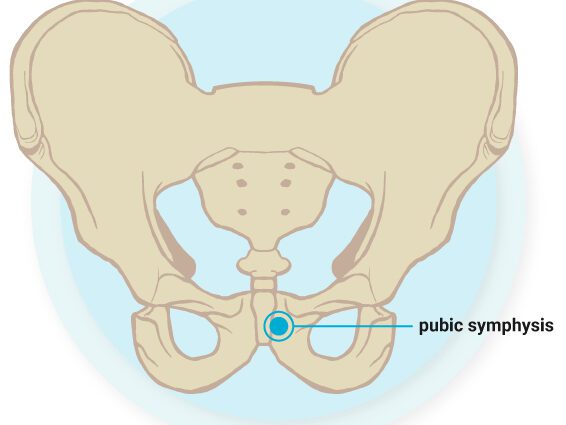Contents
Symphysis
The pubic symphysis is the joint joining the two hip bones, or iliac bones, at the front of the pelvis (1).
Anatomy of the pubic symphysis
Position. Located above the genitals and in front of the bladder, the pubic symphysis forms the anterior joint of the two hip bones. Together with the sacrum, these bones form the pelvic girdle constituting the skeleton of the pelvis. The hip bones are symmetrical bones connected together at the back by the sacrum and at the front by the pubic symphysis. Each oxal bone is made up of three bones welded together: the ilium, upper part of the coxal bone, the ischium, lower part and posteriorly, as well as the pubis, lower part and in front (2).
Structure. The pubic symphysis is a poorly mobile joint made up of:
- a fibrocartilaginous interpubic ligament, located in the center of the pubic symphysis, made up of joint cavities;
- an interpubic cartilaginous ligament, located on each side between the interpubic fibrocartilaginous ligament and the pubic bone;
- of superior and inferior ligaments covering the pubic symphysis and the pubic bone.
Functions of the pubic symphysis
Shock absorber role. The position and structure of the pubic symphysis give it a shock absorber role by adapting to the different tensile, compressive and shear stresses that the pelvis may undergo (3).
Function during childbirth. During childbirth, the pubic symphysis plays an important role thanks to its flexibility which allows a greater opening of the pelvis and easier passage of the baby.
Symphysis pathologies
The pubic symphysis and surrounding anatomical structures, such as the pubic bones, can be affected by conditions of rheumatic, infectious, degenerative or traumatic origin (4).
Pelvic deformity and fracture. Infrequent, fractures in the pelvis can involve the pubic symphysis. They are most often due to violent trauma which can in particular cause symphyseal disjunction. The latter corresponds to a displacement of a hemi-pelvis with respect to the other.
Ankylosing spondylitis. Affecting the joints of the vertebrae, and more specifically the sacroiliac joints, this rheumatic inflammatory disease can also affect the pubic symphysis (4).
osteoporosis. This pathology constitutes a loss of bone density which is generally found in people over the age of 60. It accentuates bone fragility and promotes bills. (5)
Bone dystrophy. This pathology constitutes an abnormal development or remodeling of bone tissue and includes many diseases. One of the most common, Paget’s disease (6) causes bone densification and deformation, leading to pain. As for algodystrophy, it corresponds to the appearance of pain and / or stiffness following a trauma (fracture, surgery, etc.).
Symphysis treatments
Medical treatment. Depending on the pathology diagnosed, certain drugs may be prescribed to reduce pain.
Orthopedic treatment. Depending on the type of fracture, orthopedic treatment may be implemented.
Surgical treatment. Depending on the pathology and its evolution, surgery may be performed.
Physical treatment. Physical therapies, through specific exercise programs, can be prescribed such as physiotherapy or physiotherapy.
Symphysis examinations
Physical examination. First, a physical examination is performed to identify the painful movements and the cause of the pain.
Medical imaging examination. Depending on the suspected or proven pathology, additional examinations may be performed such as an X-ray, an ultrasound, a CT scan, an MRI, a scintigraphy or a bone densitometry.
Medical analysis. In order to identify certain pathologies, blood or urine analyzes can be carried out such as, for example, the dosage of phosphorus or calcium.
History and symbolism of the symphysis
Occurring mainly in athletes, pubalgia, known as athletic, is manifested in particular by pain in the pubic symphysis.










